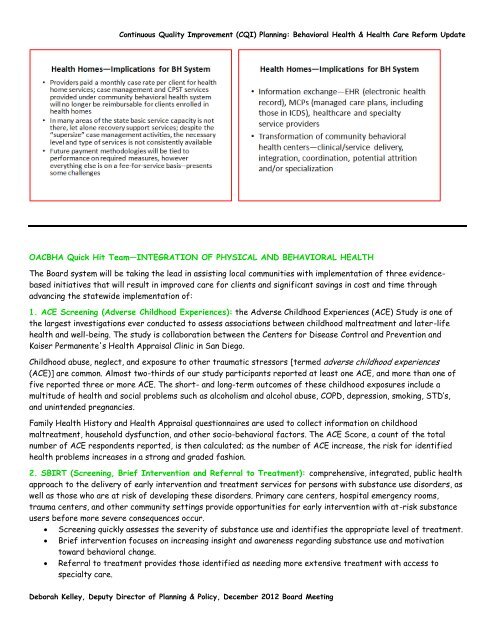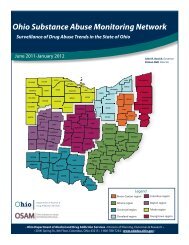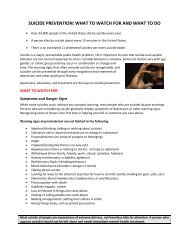Continuous Quality Improvement (CQI) Planning: Behavioral Health ...
Continuous Quality Improvement (CQI) Planning: Behavioral Health ...
Continuous Quality Improvement (CQI) Planning: Behavioral Health ...
You also want an ePaper? Increase the reach of your titles
YUMPU automatically turns print PDFs into web optimized ePapers that Google loves.
<strong>Continuous</strong> <strong>Quality</strong> <strong>Improvement</strong> (<strong>CQI</strong>) <strong>Planning</strong>: <strong>Behavioral</strong> <strong>Health</strong> & <strong>Health</strong> Care Reform Update<br />
OACBHA Quick Hit Team—INTEGRATION OF PHYSICAL AND BEHAVIORAL HEALTH<br />
The Board system will be taking the lead in assisting local communities with implementation of three evidencebased<br />
initiatives that will result in improved care for clients and significant savings in cost and time through<br />
advancing the statewide implementation of:<br />
1. ACE Screening (Adverse Childhood Experiences): the Adverse Childhood Experiences (ACE) Study is one of<br />
the largest investigations ever conducted to assess associations between childhood maltreatment and later-life<br />
health and well-being. The study is collaboration between the Centers for Disease Control and Prevention and<br />
Kaiser Permanente's <strong>Health</strong> Appraisal Clinic in San Diego.<br />
Childhood abuse, neglect, and exposure to other traumatic stressors [termed adverse childhood experiences<br />
(ACE)] are common. Almost two-thirds of our study participants reported at least one ACE, and more than one of<br />
five reported three or more ACE. The short- and long-term outcomes of these childhood exposures include a<br />
multitude of health and social problems such as alcoholism and alcohol abuse, COPD, depression, smoking, STD’s,<br />
and unintended pregnancies.<br />
Family <strong>Health</strong> History and <strong>Health</strong> Appraisal questionnaires are used to collect information on childhood<br />
maltreatment, household dysfunction, and other socio-behavioral factors. The ACE Score, a count of the total<br />
number of ACE respondents reported, is then calculated; as the number of ACE increase, the risk for identified<br />
health problems increases in a strong and graded fashion.<br />
2. SBIRT (Screening, Brief Intervention and Referral to Treatment): comprehensive, integrated, public health<br />
approach to the delivery of early intervention and treatment services for persons with substance use disorders, as<br />
well as those who are at risk of developing these disorders. Primary care centers, hospital emergency rooms,<br />
trauma centers, and other community settings provide opportunities for early intervention with at-risk substance<br />
users before more severe consequences occur.<br />
Screening quickly assesses the severity of substance use and identifies the appropriate level of treatment.<br />
Brief intervention focuses on increasing insight and awareness regarding substance use and motivation<br />
toward behavioral change.<br />
Referral to treatment provides those identified as needing more extensive treatment with access to<br />
specialty care.<br />
Deborah Kelley, Deputy Director of <strong>Planning</strong> & Policy, December 2012 Board Meeting






